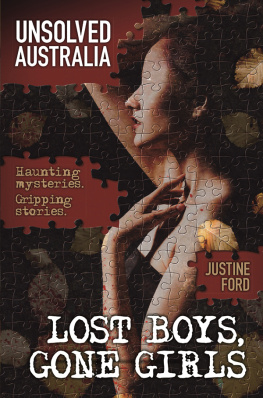About Unsolved Australia
Follow the twists and turns. Piece together the clues. Weigh the evidence. Assess the suspects. Can you catch a killer?
Australias most baffling homicides and mysterious missing persons cases are uniquely explored in Unsolved Australia, a remarkable true-crime book in which you, the reader, are invited to play armchair detective.
Crusading journalist Justine Ford shines fresh light on 18 infamous cases, unearths jaw-dropping evidence via in-depth interviews with police, criminals and families of victims, and introduces the humble heroes who never stop searching for the truth.
Unsolved Australia is a chilling, thrilling and inspiring book full of drama, emotion and hope.
UNSOLVED
AUSTRALIA
JUSTINE
FORD

CONTENTS
For the amazing Kate Mills,
with love and thanks

FOREWORD
Solving a cold case homicide is one of the most difficult challenges a detective will face in their entire policing career but also one of the most satisfying and rewarding. Ive been an investigations coordinator at the New South Wales Police Unsolved Homicide Team for six years and the cases we face continually fascinate me. In New South Wales and across Australia there are hundreds of unsolved murders and suspicious missing persons cases usually older than ten years and some dating back to the 1960s. These cases are unsolved for a reason, which is why they are also the most challenging to investigate. Some of the best detectives in policing history have worked tirelessly on murder cases without being able to finalise them and bring the offenders to justice. No unsolved homicide case is ever closed.
When a detective applies to join the Unsolved Homicide Team we look for a particular calibre of investigator. In short, they need to be the best of the best. He or she needs to be up for a challenge, tenacious, hardworking, and have the ability to fit into a team environment. They should ideally come with homicide and major crime investigation experience but, more importantly, be willing to have a go. They need to be inquisitive and open to new ideas and theories when determining strategies. They also need to be prepared for the long haul. It would be nice to solve a historical murder mystery in one hour, once a week, like on television, but the reality is that many of our investigations continue for years. Perseverance is the key. There will be many disappointments along the way and a constant realisation that many cold cases will never be solved. But it is the hope of families, friends and loved ones left behind, and the outright injustice for the victim, that drives cold case investigators. When one is solved and the offender/s responsible is put away behind bars, there is no greater feeling of satisfaction or pride.
Scientific advancements have no doubt breathed new life into many cold cases. Forensic DNA, ballistics, fingerprint technologies and other expert sciences are an incredible asset to the modern-day investigator but they cant be relied upon in isolation. I often say that a DNA breakthrough identifying a suspect in a cold case homicide is only the start, after which the real detective work begins. DNA alone will seldom be enough to secure an offenders conviction at court. When we review a case at the Unsolved Homicide Team we assess its solvability prospects based on a number of factors. These include: the availability of physical evidence from the crime scene that is suitable for new forensic examinations; the availability of identified suspects and witnesses; and finally, our ability to apply new investigative strategies that were previously untried or unavailable to the homicide investigators of yesteryear.
On one hand the passage of time makes a case harder to solve but it can also be advantageous. Relationships change over time, loyalties between witnesses or persons of interest once strong and bonded by secrecy may have eroded and new information can be gleaned which can lead to the breakthrough we so desperately need. These are the issues that matter when we decide to re-investigate a cold case. Time also means that people, including offenders, move on. Most crooks never hang around the scene of their crimes, which means that we cannot work alone. We often depend on assistance from our policing colleagues and communities across Australia and abroad to obtain success.
Interestingly, fewer than half of the sixteen cases weve solved in New South Wales since 2005 have relied solely on DNA. A recent forty-one-year-old case involving the arrest of a man for the rape and murder of a young woman in rural New South Wales had no DNA evidence whatsoever because the case exhibits didnt exist anymore. This case was more about grabbing lost opportunities and looking further than our predecessors had ever considered. Investigations like this give police and those left behind hope in other seemingly unsolvable cases.
Over the last couple of years Ive had the pleasure of working with Justine Ford as she researches many of our cold case mysteries and, like our investigators, Justine is very passionate about her work. Sadly, other than the families (the secondary victims of a homicide) and the investigators working on them, most cold cases are forgotten. Justines work is invaluable in breathing new life into many historical murders and missing persons cases and bringing them back into the minds of all of us in our communities. We in cold case investigation are highly dependent on getting new information and if Justines book can assist us in that endeavour then I cannot over-emphasise the importance of her work. We should never forget the horrific unsolved crimes Justine writes about because those who have not forgotten the victims and continue to work towards solving their cases are really their only hope.
Detective Chief Inspector John Lehmann
New South Wales Police Unsolved Homicide Team
INTRODUCTION
CAN YOU HELP CATCH A KILLER OR FIND
A MISSING PERSON?
The most valuable thing one person can steal from another is their life.
Every year in Australia there are around three hundred murders which the public can help police to solve yet many homicides rarely rate a mention in the daily news.
It is the same with missing people. Thirty-eight thousand Australians vanish every year and, while most turn up, what about the others? As time goes by, their families feel as though their loved ones have been forgotten.
If Unsolved Australia has anything to do with it, Australias murdered and missing will never be forgotten.
Unsolved Australia asks you to help solve some of this countrys most mysterious murders; track down missing people; and identify a John Doe.
The book is made possible because of the victims families who have graciously opened their hearts and homes to offer realistic and moving insights into the lives of their murdered or missing loved ones.
Then there are the heroes of the book: the incredible homicide detectives and cold case investigators, who reveal important clues for the first time. It has been a great privilege to interview these men and women, who are among the best major crime investigators in Australia. They have generously entrusted me with crucial and sensitive information and, with their blessing, I can now pass this on to you.
As you read about these enthralling cases, you might find that you have the missing piece of the puzzle police need to solve a case. Then again, you might be a true crime reader whos compelled by a baffling whodunit.




















